
Indonesia is a country with many different tribes and ethnic groups, and its music is also very diverse, coming in hundreds of different forms and styles. Every region has its own culture and art, and as a result traditional music from area to area also uniquely differs from one another. For example, each traditional type of music is often accompanied by its very own dance and theatre. Contemporary music scene have also been heavily shaped by various foreign influences, such as America, Britain, Japan, Korea, and India.
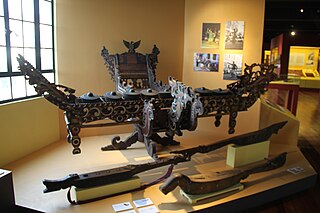
Kulintang is a modern term for an ancient instrumental form of music composed on a row of small, horizontally laid gongs that function melodically, accompanied by larger, suspended gongs and drums. As part of the larger gong-chime culture of Southeast Asia, kulintang music ensembles have been playing for many centuries in regions of the Southern Philippines, Eastern Malaysia, Eastern Indonesia, Brunei and Timor, Kulintang evolved from a simple native signaling tradition, and developed into its present form with the incorporation of knobbed gongs from Sundanese people in Java Island, Indonesia. Its importance stems from its association with the indigenous cultures that inhabited these islands prior to the influences of Hinduism, Buddhism, Islam, Christianity or the West, making kulintang the most developed tradition of Southeast Asian archaic gong-chime ensembles.

The Minahasans or Minahassa are an indigenous ethnic group from the North Sulawesi province of Indonesia, formerly known as North Celebes. The Minahasa people sometimes refer to themselves as Manado people. Although the Minahasan pre-Christian creation myth entails some form of ethnic unification, before the nineteenth century the Minahasa region was in no way unified. Instead, a number of politically independent groups (walak) existed together, often in a permanent state of conflict.

The angklung is a musical instrument from the Sundanese in Indonesia that is made of a varying number of bamboo tubes attached to a bamboo frame. The tubes are carved to produce a resonant pitch when struck and are tuned to octaves, similar to Western handbells. The base of the frame is held in one hand, while the other hand shakes the instrument, causing a repeating note to sound. Each performer in an angklung ensemble is typically responsible for just one pitch, sounding their individual angklung at the appropriate times to produce complete melodies.

The culture of Indonesia has been shaped by the interplay of indigenous customs and diverse foreign influences. With over 1,300 distinct ethnic groups contributing to its rich traditions, languages, and customs, Indonesia is a melting pot of diversity. Positioned along ancient trade routes between the Far East, South Asia, and the Middle East, the country has absorbed cultural practices influenced by Hinduism, Buddhism, Confucianism, Islam, and Christianity. These influences have created a complex cultural tapestry that often differs from the original indigenous cultures.
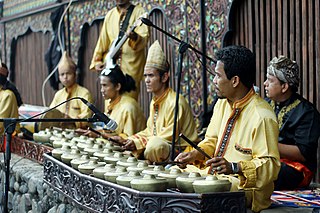
Talempong is a traditional music of the Minangkabau people of Western Sumatra, Indonesia. The talempong produce a static texture consisting of interlocking rhythms.

Kolintang is a traditional Minahasan percussion instrument from North Sulawesi, Indonesia, consisting of wooden blades arranged in a row and mounted on a wooden tub. Kolintang is usually played in ensemble music. Kolintang in the Minahasan community is used to accompany traditional ceremonies, dance, singing, and music. The wood used to make Kolintang blades is light but strong local wood such as Telur wood, Wenuang wood, Cempaka wood, Waru wood, and the like which have a fiber construction. parallel. Meanwhile, kolintang resonator crates are usually made of hardwood materials such as teak or mahogany.
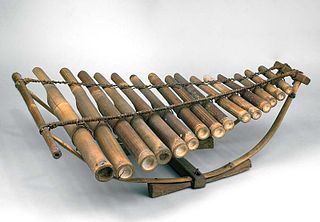
The Calung is a type of Indonesian bamboo xylophone originating from Baduy culture and commonly used in Baduy, Bantenese, Sundanese, Banyumasan, and Balinese performances. The calung (instrument) consists of multiple bamboo tubes which are struck at the base to produce a woody sound.

Dance in Indonesia reflects the country's diversity of ethnicities and cultures. There are more than 1,300 ethnic groups in Indonesia. Austronesian roots and Melanesian tribal forms are visible, and influences ranging from neighboring Asian and even western styles through colonization. Each ethnic group has its own dances: there are more than 3,000 original dance forms in Indonesia. The old traditions of dance and drama are being preserved in the numerous dance schools which flourish not only in the courts but also in the modern, government-run or supervised art academies.

Sapeh, also spelled sape, sapeʼ, sapek, sapeik, sapeq, sampeh, sampeʼ, sampek, or sampeq is a traditional string instrument of Borneo-origin that developed in northern, eastern, and central regions of Kalimantan. It is a wooden-base instrument with strings attached, and works in a manner similar to the guitar.

Bamboo's natural hollow form makes it an obvious choice for many musical instruments. In South and South East Asia, traditional uses of bamboo the instrument include various types of woodwind instruments, such as flutes, and devices like xylophones and organs, which require resonating sections. In some traditional instruments bamboo is the primary material, while others combine bamboo with other materials such as wood and leather.
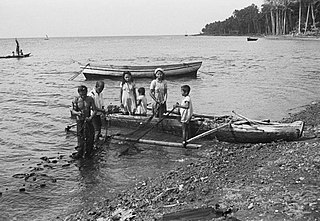
Sangirese or Sangihe people are one of the native people of the Sangir Islands in the northern chain of islands in Sulawesi and the southern part of Mindanao. The Sangirese people are fishermen and nutmeg growers in their home areas and also work as wage labourers in industrial crops enterprises in Bolaang Mongondow Regency and Minahasa Regency.

Banyumasan or Banyumasan Javanese is a collective term for a Javanese subgroup native to the Indonesia's westernmost part of Central Java. At approximately ±9 million people, they are concentrated in Banyumas, Cilacap, Kebumen, Purworejo, Purbalingga, and Banjarnegara regencies. The Banyumasan-Javanese speak Banyumasan dialect of Javanese language, a dialect which is often called "basa ngapak-ngapak".

Sundanese Music is an umbrella term that encompasses diverse musical traditions of the West Java and Banten in western part of Java, Indonesia. The term of "West Java" is preferred by scholars in this field. The word "Sundanese" originally referred to western part of Java Island and has a strong association with the highly centralized Sunda Kingdom based on Java Island and its high culture practiced by the nobleman class in its capital Parahyangan. By contrast, scholars who cover a much broader region lay emphasis on folk culture.

A tifa totobuang is a music ensemble from the Maluku Islands, related to the kulintang orchestra. It consists of a set of a double row of gong chimes known as the totobuang and a set of tifa drums. It can also include a large gong.

Tarawangsa is a traditional Sundanese musical instrument from West Java, Indonesia, in the form of a stringed instrument that has two strings made of steel or iron wire. Tarawangsa is an ensemble of chordophones of two musical instruments. One is called tarawangsa itself, played by swiping and the other is called jentreng played by picking. The art of Tarawangsa is performed in the Ngalaksa ceremony, which is a ceremony for abundant harvests. The ceremony in the traditional agrarian society of the Sundanese is always identified with the figure of Nyai Sri Pohaci or Nyi Pohaci Sanghyang Dangdayang Asri or Dewi Asri or Dewi Sri as the Sundanese goddess of rice.
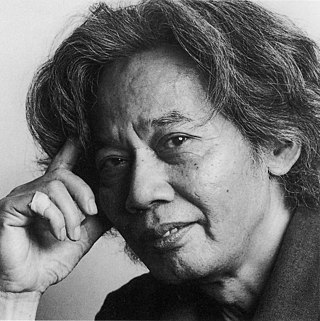
Paul Gutama Soegijo was an Indonesian composer and musician, active in Berlin. Born in Yogyakarta on the island of Java, Soegijo studied composition with Boris Blacher at Berlin's Hochschule für Musik. He began his compositional career in the experimental Neue Musik style but later transitioned to using elements of Indonesian music in his works, particularly the gamelan percussion instruments. He visited Indonesia between 1977 and 1985 to study the gamelan instruments, and in his later works he often combined Western influences with the gamelan traditions that he learned.
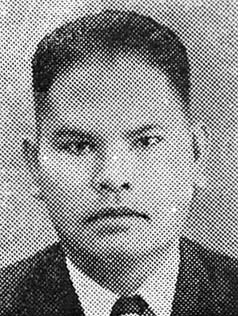
Amir Hamzah Pasaribu (1915–2010) was an Indonesian composer, pianist, cellist, cultural critic and music pedagogue. He was one of the first Indonesians to study classical music abroad and was very active in music composition, education and performance during the first two decades of Indonesian independence, and he founded the Indonesian Musician's Union. During the New Order period he left Indonesia for Suriname where he worked as a music teacher and orchestral musician, returning to Indonesia in 1996.

Kurung-kurung is a traditional Banjar musical instrument originating from South Kalimantan, Indonesia. Kurung-kurung instrument is made of long wood and the bottom is made of bamboo. This musical instrument can make a sound after being pounded to the ground and the rhythm of the music released will be different from each other, to make a different rhythm, the music player will pound the instrument alternately according to the desired rhythm.
Benius Petrus Peter Lengkong, better known as Petrus Lengkong, was an Indonesian artist and former Indonesian Army officer best known for popularizing Dayak arts, especially wood carving and sculpture. Due to his work in preserving Dayak arts and culture, he received several awards from Indonesian government.




















